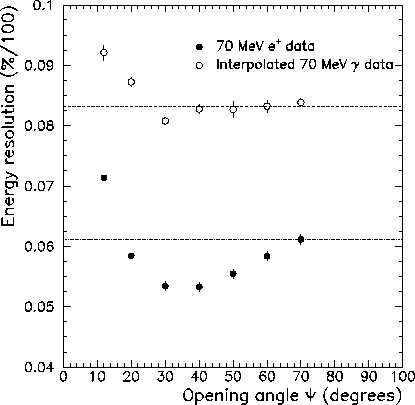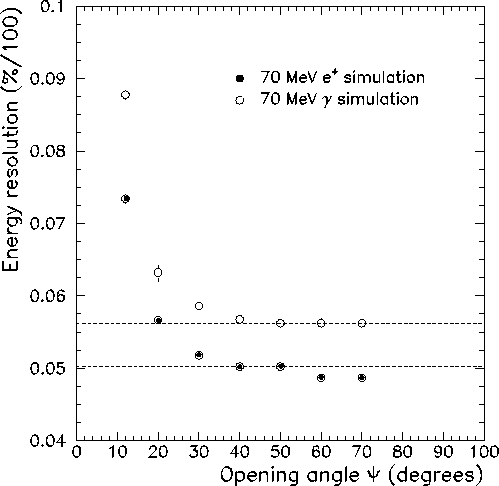The optimal cluster size for best energy resolution has been found
by applying the cone technique to data obtained from a 70 MeV positron
beam, and from a subset of photons selected from the photon box spectrum
in the reaction ![]() . This subset
contains photons with energies close to 55 and 83 MeV, and is selected
kinematically by requiring that the relative angle
. This subset
contains photons with energies close to 55 and 83 MeV, and is selected
kinematically by requiring that the relative angle ![]() between the two
photons be greater than 175
between the two
photons be greater than 175![]() (See Chapter 7).
By interpolating between the results for photons at these two
energies 55 and 83 MeV, one can deduce and plot the results for
70 MeV photons. Finally, due to the fact that the photons were
incident on the detector array isotropically, and the 70 MeV positron
beam was concentrated at the center of the array, a cut has been
implemented in the photon data such that less than 2 MeV are deposited
in the outer ring of crystals. Figure 6.3 shows the plot
of energy resolution against cluster size for these two data sets.
(See Chapter 7).
By interpolating between the results for photons at these two
energies 55 and 83 MeV, one can deduce and plot the results for
70 MeV photons. Finally, due to the fact that the photons were
incident on the detector array isotropically, and the 70 MeV positron
beam was concentrated at the center of the array, a cut has been
implemented in the photon data such that less than 2 MeV are deposited
in the outer ring of crystals. Figure 6.3 shows the plot
of energy resolution against cluster size for these two data sets.

Figure 6.3: Energy resolution, defined as full width half maximum divided
by peak position of the response function, plotted as a function of the
cone opening angle ![]() , for 70 MeV positron and interpolated 70 MeV
photon data. The horizontal dotted lines represent the asymptotic values
for 360
, for 70 MeV positron and interpolated 70 MeV
photon data. The horizontal dotted lines represent the asymptotic values
for 360![]() summing. Less than 2 MeV have been deposited in the outer
ring of crystals for the photon results.
summing. Less than 2 MeV have been deposited in the outer
ring of crystals for the photon results.
One can see that the energy resolution appears to be optimal for a
cone angle of about 30![]() .
.
For comparison, the 70 MeV positron and 70 MeV photon data have been
simulated with the GEANT program. For the simulation, the
70 MeV photon results have been taken directly from the monoenergetic
response, and not from the interpolation of the 55 and 83 MeV results.
However, the 70 MeV photons have been thrown isotropically at the
44-element array, and a cut of 2 MeV on the outer ring has been implemented.
Figure 6.4 shows the plot of energy resolution against cluster
size for the simulated 70 MeV positron and photons. From this plot, one can
see that the energy resolution approaches its optimal value for an opening
angle of 30![]() .
.

Figure 6.4: Energy resolution, defined as full width half maximum divided
by peak position of the response function, plotted as a function of the
cone opening angle ![]() , for simulated 70 MeV positrons and 70 MeV
photons. The dotted horizontal lines represent the asymptotic values
for 360
, for simulated 70 MeV positrons and 70 MeV
photons. The dotted horizontal lines represent the asymptotic values
for 360![]() summing.
summing.